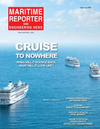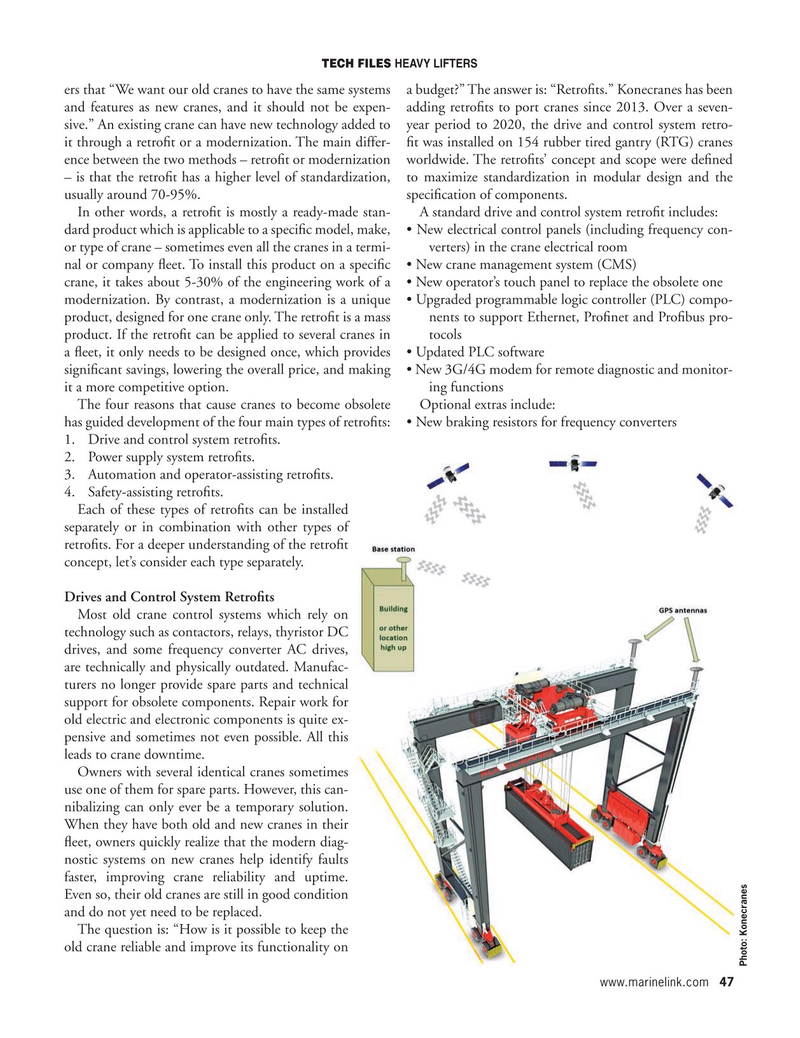
Page 47: of Maritime Reporter Magazine (February 2021)
Government Shipbuilding
Read this page in Pdf, Flash or Html5 edition of February 2021 Maritime Reporter Magazine
TECH FILES HEAVY LIFTERS ers that “We want our old cranes to have the same systems a budget?” The answer is: “Retro? ts.” Konecranes has been and features as new cranes, and it should not be expen- adding retro? ts to port cranes since 2013. Over a seven- sive.” An existing crane can have new technology added to year period to 2020, the drive and control system retro- it through a retro? t or a modernization. The main differ- ? t was installed on 154 rubber tired gantry (RTG) cranes ence between the two methods – retro? t or modernization worldwide. The retro? ts’ concept and scope were de? ned – is that the retro? t has a higher level of standardization, to maximize standardization in modular design and the usually around 70-95%. speci? cation of components.
In other words, a retro? t is mostly a ready-made stan- A standard drive and control system retro? t includes: dard product which is applicable to a speci? c model, make, • New electrical control panels (including frequency con- or type of crane – sometimes even all the cranes in a termi- verters) in the crane electrical room nal or company ? eet. To install this product on a speci? c • New crane management system (CMS) crane, it takes about 5-30% of the engineering work of a • New operator’s touch panel to replace the obsolete one modernization. By contrast, a modernization is a unique • Upgraded programmable logic controller (PLC) compo- product, designed for one crane only. The retro? t is a mass nents to support Ethernet, Pro? net and Pro? bus pro- product. If the retro? t can be applied to several cranes in tocols a ? eet, it only needs to be designed once, which provides • Updated PLC software signi? cant savings, lowering the overall price, and making • New 3G/4G modem for remote diagnostic and monitor- it a more competitive option. ing functions
The four reasons that cause cranes to become obsolete Optional extras include: has guided development of the four main types of retro? ts: • New braking resistors for frequency converters 1. Drive and control system retro? ts.
2. Power supply system retro? ts.
3. Automation and operator-assisting retro? ts.
4. Safety-assisting retro? ts.
Each of these types of retro? ts can be installed separately or in combination with other types of retro? ts. For a deeper understanding of the retro? t concept, let’s consider each type separately.
Drives and Control System Retro? ts
Most old crane control systems which rely on technology such as contactors, relays, thyristor DC drives, and some frequency converter AC drives, are technically and physically outdated. Manufac- turers no longer provide spare parts and technical support for obsolete components. Repair work for old electric and electronic components is quite ex- pensive and sometimes not even possible. All this leads to crane downtime.
Owners with several identical cranes sometimes use one of them for spare parts. However, this can- nibalizing can only ever be a temporary solution.
When they have both old and new cranes in their ? eet, owners quickly realize that the modern diag- nostic systems on new cranes help identify faults faster, improving crane reliability and uptime.
Even so, their old cranes are still in good condition and do not yet need to be replaced.
The question is: “How is it possible to keep the old crane reliable and improve its functionality on
Photo: Konecranes www.marinelink.com 47
MR #2 (34-49).indd 47 2/4/2021 10:03:27 AM

 46
46

 48
48
